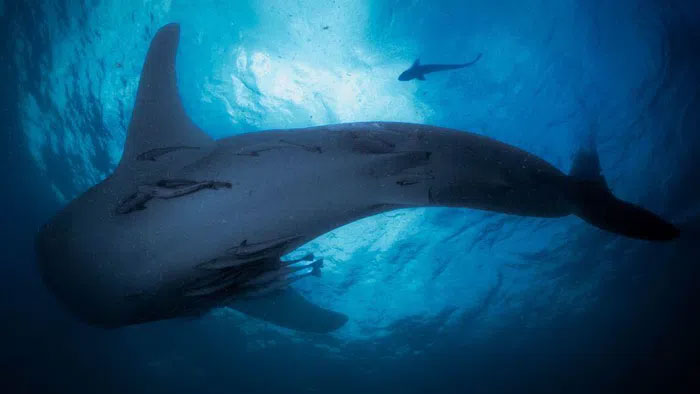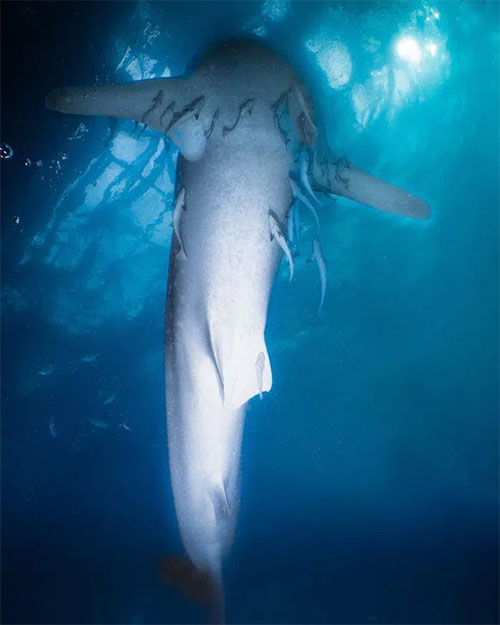At 4:30 AM, the sky was still pitch black, the sea calm, and the crescent moon slowly fading. A flock of Papuan hornbills soared past the boat, their sounds resembling a helicopter flying overhead.
Anita Verde, a writer for BBC, arrived at Triton Bay after hearing about the incredible underwater landscapes found here. Triton Bay is also renowned as a great spot for photographers looking to “capture” whale sharks. There are not many destinations around the world that allow diving with whale sharks, making Triton even more special.
Living with Whale Sharks
The boat took Verde to the wooden fishing platforms, known as bagan in the local language. Whale sharks are expected to appear here.
The bagan were constructed by the Bugis – an ethnic group originating from southern Celebes, now known as Sulawesi in Indonesia. They are often referred to as “pirates” or “sea nomads.”
The Bugis spend most of their lives adrift at sea with their bagan. They travel long distances to find the best fishing waters. Over generations, they have developed a unique relationship with whale sharks.

The bagan are the only places to access whale sharks.
Every morning, the whale sharks gather and feed beneath their nets. Their food consists of sardines that escape through small gaps in the nets.
There are many places around the world where whale sharks can be found, such as Christmas Island in Australia, Ningaloo Reef, the Galapagos Islands, and the waters off Donsol (Philippines)… However, in these locations, the giant creatures only appear fleetingly.
In Triton Bay, whale sharks are present year-round. Wherever the Bugis and their bagan go, the whale sharks follow. The reason? To receive free meals.
The Gentle Giants
There are no services for booking dives with whale sharks here. You have to find the Bugis and ask for permission. Aching, a Bugis fisherman, agreed to take Verde out on his boat.
Every generation in Aching’s family has followed this trade. In the past, the Bugis fished only to sustain their own lives and for small trade with the local community. However, the scale of this industry has grown significantly. They no longer just supply local markets.

Whale sharks are rarely seen in waters with temperatures below 21 degrees Celsius. They only eat plankton and small marine animals and pose no threat to humans.
Aching fished all night, and now his nets were full. He was relaxing in the morning sunlight.
“He signaled for us to look beneath the sea. Immediately, we saw a massive whale shark. They are the largest fish in the world, with bodies as long as a bus. Its size is truly impressive,” the BBC writer recounted.
Aching mentioned that there were actually three whale sharks lingering beneath his bagan. Therefore, Aching left a net full of small sardines underwater for them to feed on.
The Bugis refer to whale sharks as ikan bodo (dumb fish) due to their gentle and docile nature. The Bugis community holds whale sharks in high regard and considers them a symbol of good luck.
Over generations, Aching’s family has “nurtured” their relationship with these giant fish. They hope that the whale sharks will reward them with bountiful catches. Thus, every morning when casting their nets, he always leaves a catch underwater for the whale sharks to enjoy.
“They are just small fish. They only like the small ones,” he said.

Whale sharks are the largest living non-mammalian vertebrates.
Like dolphins, whale sharks are viewed as symbols of good fortune. This is supported by scientific evidence. The presence of whale sharks is significant for fishermen.
They attract species such as anchovies, mackerel, and tuna to the feeding grounds. It can be said that whale sharks are one of the important indicators of the ecosystem’s “health.”
“Overall, they help balance the food chain and ensure a rich food supply for the Bugis,” shared Iqbal Herwata, a representative from the Indonesia office of Conservation International.


















































